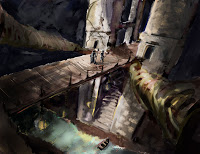 This past weekend allowed me time to get most of the first level (well, it’s more of an “area” than a level) of my Glitterdark dungeon worked up, in time for this Friday’s game. As some may recall, just as my players had reached the place, and even entered a room or three, I had a vision about taking it into a completely new direction.
This past weekend allowed me time to get most of the first level (well, it’s more of an “area” than a level) of my Glitterdark dungeon worked up, in time for this Friday’s game. As some may recall, just as my players had reached the place, and even entered a room or three, I had a vision about taking it into a completely new direction.
Up until then, Glitterdark was a fairly conventional dungeon complex, albeit with a few neat things that were a bit out of the ordinary. 20 or so levels stacked pretty much on top of one another, with an enormous central chasm that cut through nearly half the place, filled with flying buttresses, ramps, and staircases, to give the whole thing more of an “open” feeling. But it had a conventional set of maps and encounter key.
No more.
Now Glitterdark is a much more expansive setting. It spreads under Mount Arak for miles, much like the Underdark, but on a smaller scale. Miles-long tunnels connect different encounter areas, each of which is like unto a separate dungeon. And no longer is it a conventional map-and-key design. Here’s where the “cyborg” part comes in. Where a conventional dungeon has a map and an encounter key, Glitterdark has only the skeleton of a map and a key, maybe comprising a quarter of the total area of any given level. Into the map are plugged in geomorphic sections, which are keyed randomly through a master table as play goes on. Roll three dice and you can find out everything in a given room; all the rolling on sub-tables and so forth has already been done (I’ve run into that problem with random dungeons; trying to figure out what the trap is, or how many orcs are in a room, always seems to involve a lot of rolling and consulting tables which just slows things down in actual play).
So now I have the best of both worlds. The “skeleton” is there to provide for the various set-piece encounters, memorable traps, magic items, and NPCs, etc. The “meat” is the geomorphs and the random tables to populate them. Everything’s in keeping with the various themes of each area; it’s not just taking the random encounter tables out of the DMG and tossing orcs next to skeletons next to giant centipedes. And the best part is that this makes the dungeon in large part re-usable. Play it in one game and it will look one way. Play it under another GM and, aside from a few “big things” it will be completely different.
It also has the benefit of being MUCH easier to create. Once the random tables are in place, pre-rolling them becomes a snap. Naturally, a lot of thought goes into them, and they’ll be customized to the needs and theme of each encounter area, but it’s a lot faster process than writing all those encounter areas individually.
Anyway, this Friday will tell whether this crackpot scheme of combining random geomorphs with a set-piece framework works. I’m very excited to see how it plays out.









Interested to see more details of how this plays out!
This sounds like a great idea. What charts are you using? Something someone else could access?
Sounds like an idea with a lot of promise. I hope it works out!
I too would be interested in seeing something about how things go as well as more details about how you went about creating the skeleton, tables, etc.
A fascinating take on the dungeon campaign. This has the potential to make an epic and memorable environment on a scale that most DMs can barely hope to achieve.
I look forward to hearing more, especially as it has the potential to work for many settings. Thinking the underdark on the way to Vault of the Drow…..
Has potential to be a great gaming resource, and i would certainly put cash down for some well designed tables 🙂